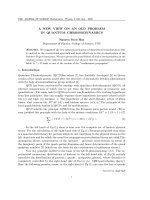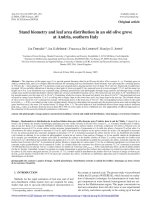there was an old woman
Bạn đang xem bản rút gọn của tài liệu. Xem và tải ngay bản đầy đủ của tài liệu tại đây (5.5 MB, 14 trang )
There Was an
Old Woman
Illustrated by Virginia Allyn
No part of this publication may be reproduced in whole or in part or stored in a retrieval system, or transmitted in any
form or by any means, electronic, mechanical, photocopying, recording, or otherwise, without written permission of the
publisher. For information regarding permission, write to Scholastic Inc., 557 Broadway, New York, NY 10012.
Designed by Jaime Lucero
ISBN: 978-0-545-26776-2
Copyright © 2010 by Scholastic Inc.
All rights reserved. Published by Scholastic Inc.
12 11 10 9 8 7 6 5 4 3 2 1 10 11 12 13 14 15/0
N
u
r
s
e
r
y
R
h
y
m
e
N
u
r
s
e
r
y
R
h
y
m
e
READERSREADERS
Nursery Rhyme Readers: There Was an Old Woman © Scholastic Teaching Resources
2
There was an old woman
Nursery Rhyme Readers: There Was an Old Woman © Scholastic Teaching Resources
3
who lived in a shoe.
Nursery Rhyme Readers: There Was an Old Woman © Scholastic Teaching Resources
4
She had so many children,
Nursery Rhyme Readers: There Was an Old Woman © Scholastic Teaching Resources
5
she didn’t know what to do.
Nursery Rhyme Readers: There Was an Old Woman © Scholastic Teaching Resources
6
So she gave them some broth
Nursery Rhyme Readers: There Was an Old Woman © Scholastic Teaching Resources
7
and plenty of bread.
Nursery Rhyme Readers: There Was an Old Woman © Scholastic Teaching Resources
8
Then she kissed them sweetly
and put them to bed.
Nursery Rhyme Readers: There Was an Old Woman © Scholastic Teaching Resources
6
Teaching Tips
To enhance children’s reading experiences, use these tips
as you introduce and share the Nursery Rhyme Readers.
Before Reading
Show the cover of the book and read aloud the title.
Have children comment on the cover illustration and
tell what they know about the nursery rhyme. Since
nursery rhymes often contain unfamiliar vocabulary,
skim the book and introduce any vocabulary that will help
children’s understanding of the story. For example, for Little
Miss Muffet, discuss tuffet, curds, and whey.
During Reading
The first time through, read the nursery rhyme aloud from beginning to end to let children hear the
rhyme, enjoy it, and get a feel for the language. On subsequent readings, help engage children in the
reading process by following these suggestions.
L
Model reading for children by tracking a line of print from left to right, turning the pages, and
using picture clues. Invite children to comment on the illustrations on each page.
L
Reread the story, asking children to listen for words that rhyme. Then read aloud again, this time
stopping at words that rhyme and letting children chime in on them. Next, invite children to join
in for a shared reading, pointing to each word as you read it.
L
Model strategies for decoding words, such as finding beginning sounds, using picture clues, and
sounding out words.
L
Point out punctuation and capital letters. Discuss what symbols such as periods,
commas, questions marks, and exclamation marks mean, and how they affect the
reading of the rhyme.
L
Invite children to clap their hands along with you to the rhythm of the rhyme as
you read aloud.
After Reading
Help children respond to the nursery rhyme by following these suggestions.
L
Ask questions to check for understanding. For example, after reading
Humpty Dumpty, ask questions such as: What happened to Humpty when he
fell? Who tried to help Humpty after he fell? Why couldn’t the king’s horses and
men put Humpty back together?
Nursery Rhyme Readers Teaching Guide © Scholastic Teaching Resources
7
L
Ask children if they liked the rhyme, and what they liked most or least.
Have them retell the rhyme in their own words.
Using the Reproducible Nursery Rhyme Pages
After reading a nursery rhyme several times, give children a copy of the nursery
rhyme reproducible to use for independent reading, for reading in pairs or groups,
for classroom activities, and for sharing with
family members. These pages are a great way to
encourage repeated readings, develop fluency, and
to do specific skill work.
Have children make a folder of the nursery
rhyme pages. Provide a blank folder for children to
title “My Nursery Rhymes,” and let them decorate
it. Have them insert the nursery rhymes as they read
them. They can also keep the Nursery Rhyme
Reader Log in the folder, as well as activity
sheets that they complete. Let children take
home the folder to share with family members
from time to time.
Have children follow along as you read
the rhyme, tracking the print as you read. Ask them to underline or circle
the rhyming words on their sheet. Also use the pages to have children
identify specific letters, words with specific consonants, blends, vowel
patterns, phonograms, and sight words. (You might wish to enlarge one copy
of the rhyme and place it on an easel for children to see.)
Some of the lesson pages have specific suggestions for using the reproducible
versions of the nursery rhymes.
Using the Lesson Pages and Reproducible
Activity Pages
For each Nursery Rhyme Reader, use the activities on the lesson page found in
this teaching guide to delve further into the areas of phonemic awareness, phonics,
comprehension, vocabulary, reading, and writing. Each nursery rhyme includes a
reproducible activity page specific to it. Spread the lesson and activities for each
rhyme over several days.
Nursery Rhymes Readers Teaching Guide •
© 2010 Scholastic • 26
Mary Had a
Little Lamb
Mary had a little lamb
with fleece as white as snow.
And everywhere that Mary went,
the lamb was sure to go.
He followed her to school
one day,
which was against the rule.
It made the children laugh and
play to see a lamb at school.
Nursery Rhymes Readers Teaching Guide •
© 2010 Scholastic • 42
Name ___________________________________________________________
Mary Had a Little Lamb
Write Your Own Story!
Mary’s lamb followed her
__________________________________________
_____________________________________________________________________________
.
What happened?
_____________________________________________________
_____________________________________________________________________________
.
to soccer
practice.
It got the ball and
butted it into the goal.
Jack
Nursery Rhyme Readers Teaching Guide © Scholastic Teaching Resources
Nursery Rhyme Readers Teaching Guide •
© 2010 Scholastic • 18
There Was an
Old Woman
There was an old woman
who lived in a shoe.
She had so many children,
she didn’t know what to do.
So she gave them some broth
and plenty of bread.
Then she kissed them sweetly
and put them to bed.
19
There Was an Old Woman
Learning With the Nursery Rhyme
See pages 6–7 for suggested ways to read and share the book with children. Then focus on the
following activities.
What Should She Do? Invite children to retell the rhyme in their own words. Ask, What was the
old woman’s problem? (She had so many children she didn’t know what to do.) What did the old woman
do? (She gave them some broth and bread and then put them to bed.) Be sure children know that
broth is a clear soup. Ask children what they think the old woman should do with all those children.
Encourage them to be creative! Record their ideas on chart paper.
Which Sound? Copy and distribute the reproducible version of the rhyme. Say the word there,
emphasizing the /th/ sound. Have children circle the letters th. Then have children find other
instances of /th/, circle the letters, and say the words (them, then). Follow the same procedure for /sh/
as in shoe and she, /ch/ as in children, and /br/ as in broth and bread. Next, write incomplete words and
have children write th, sh, ch, or br to complete the words. Use endings such as the following: __is, __
at, __ose, __ot, __ip, __ine, __at, __op, __oke, __ing, __ave, __ick. Some words may be completed with
more than one sound!
Sight Word Concentration Reread the rhyme, focusing on the sight words
(shown on page 38). Say and point to each word, and have children repeat it.
Then, copy and distribute the word cards on page 38 and help children cut
them apart. Have children play Sight Word Concentration in pairs with two
sets of cards. (Begin with a smaller number of words to make the game more
manageable.) The cards are spread facedown, and each player turns over two cards
and reads aloud the word on each card. If the two cards match, the player gets to
keep the cards. If not, the player turns the cards over in their original position.
Each player continues in turn until all the pairs have been found. Use the cards in
the word wall as described on page 8.
Rhyme Time Make rhymes with the sight words from the reader. Write the
sight word on chart paper and challenge children to come up with words that
rhyme. Show them that some of the rhyming words have the same spellings and
some have different spellings. Some examples are below:
there, where, dare, care she, he, we, see, tree, bee, sea
an, can, man, ran, fan old, cold, hold, fold, gold
who, do, boo, to, too, two in, pin, win, thin, fin
so, know, go, grow, show, no gave, wave, brave, cave
some, come, from all, call, fall, tall, small, ball
then, when, hen, men
A New House Ask children if people could really live in a big shoe, then have them name some
real places that people live. Invite them to draw a picture of a different kind of home for the old
woman and her children. Make a bulletin board display of children’s drawings.
Nursery Rhyme Readers Teaching Guide © Scholastic Teaching Resources
Nursery Rhymes Readers Teaching Guide •
© 2010 Scholastic • 38
There Was an Old Woman
Sight Word Concentration
there was an old
who lived in a
she had so many
know what to do
gave them some of
all then and put









